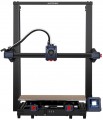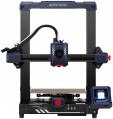Object dimensions (HxWxD)
The maximum dimensions of a product that can be printed on a 3D printer in one cycle.
The larger the dimensions of the model, the wider the choice for the user, the greater the variety of sizes available for printing. On the other hand, "large-sized" printers take a lot of space, and this parameter significantly affects the cost of the device. In addition, while printing a large model with FDM/FFF (see "Printing Technology"), larger nozzles and higher print speeds are desirable — and these features negatively affect detailing and the print quality of tiny objects. Therefore, while choosing, you should not aim the utmost maximum sizes — you should realistically assess the dimensions of the objects that you're going to print, and proceed from these data (plus a small margin in case of unexpected moments). In addition, we note that a large product can be printed in parts, and then piece these parts together.
Object volume
The largest volume of an object that can be printed on a printer. This indicator directly depends on the maximum dimensions (see above) — usually, it corresponds to these dimensions multiplied by each other. For example, dimensions of 230x240x270 mm will correspond to a volume of 23*24*27 = 14,904 cm³, that is, 14.9 litres.
The exact meaning of this indicator depends on the printing technology used (see above). These data are fundamental for photopolymer technologies SLA and DLP, as well as for powder SHS: the volume of the model corresponds to the amount of photopolymer/powder that needs to be loaded into the printer to print the product to the maximum height. If the size is smaller, this amount may decrease proportionally (for example, printing a model at half the maximum height will require half the volume), however, some printers require a full load regardless of the size of the product. In turn, for FDM/FFF and other similar technologies, the volume of the model is more of a reference value: the actual material consumption there will depend on the configuration of the printed product.
As for specific figures, the volume
up to 5 litres can be considered as small,
from 5 to 10 litres — medium,
more than 10 litres — large.
Min layer thickness
The smallest thickness of a single layer of material that can be applied with a printer.
In photopolymer devices of SLA and DLP formats (see "Print Technology") the meaning of this parameter is simple: it is the smallest height of a one pass cycle of the working platform. The smaller this height, the better detailing can be achieved on the device; however, in such models, this height is usually small — most often
less than 50 µm. But in devices based on FDM/FFF and similar technologies using nozzles, there are also higher rates —
51 – 100 µm and even
more. Here it is worth noting the fact that a small minimum layer thickness allows efficient use of small nozzles and achieves better detail. On the other hand, increasing detailing reduces productivity, and to compensate this fact, it is necessary to increase the print speed by increasing power (both heating and blowing), which, in turn, affects the cost. Therefore, choosing one should proceed from real needs: for objects with relatively low detail, there is no need to look for a printer with a small layer thickness.
It is worth noting that in FDM/FFF printers, the optimal layer thickness depends on the nozzle diameter (see below) and the specifics of printing — for example, for a “in one line” perimeter without filling, you can use the minimum layer thickness, while for filling it is not recommended. Det
...ailed recommendations on the optimal layer thickness for different situations can be found in special guides.Heating bed temperature
Maximum heating temperature in 3D printers with heated bed (for more details, see the relevant paragraph). The higher the limit, the more varieties of plastic can be used for printing. So, models with heating up to 100 °C are suitable for 3D printing with PLA plastic, with a bed temperature of 100 to 120 °C — for working with ABS plastic and nylon, high-temperature ones — allow the use of polycarbonate and refractory varieties of plastic.
Data transfer
Data transfer methods provided in the 3D printer design. We are talking primarily about data relating to the model being printed (from which the printer directly prints), in some cases also about setting up the device and other ways of interacting with it; For more details, see individual list items.
As for specific options, in addition to the traditional
communication to a PC via USB or
USB type C, modern printers may provide data transfer methods such as
a card reader, its own
USB port, a network communication via
LAN, as well as a wireless communication via
Wi-Fi. Here are the features of each of these options:
- Card reader. The printer has its own memory card slot. Most often designed to work with popular SD cards; however, even such media have several varieties, so it would not hurt to check the range of supported cards separately. In any case, the main purpose of this function is direct printing: by installing a card with a recorded project file in the printer, you can make a model without even connecting the device to a computer. There may be other ways to use the card reader - for example, copying materials from a model scanner to external media (see “Functions and capabilities”). Note that this function is convenient mainly for exchanging dat
...a with a laptop - a slot for memory cards is available in almost any modern laptop.
- USB. Own USB connector on the printer body. It is used similarly to the card reader described above - for working with external media, in this case “flash drives” and other similar devices. The methods for using the USB port are also similar - mainly direct printing, but other options are also possible (copying data from a scanner, updating firmware, etc.).
— USB type C. Availability of a USB type C port in the interface communication shelf of the device. Such connectors are smaller in size compared to classic USB, and they also have a convenient double-sided design that allows you to connect the plug to either side. USB type C is supposed to be used to connect a 3D printer to a computer or mobile gadgets for managing and transferring printed files. At the same time, this connector can be used to connect external storage media.
- Wi-Fi. A wireless communication module that can be used both to connect the printer to local networks and for direct communication with tablets, laptops and other gadgets. Specific capabilities should be clarified separately, but here we note that a network communication allows you to use the printer as a common device for all computers on the local network and even access it from the Internet (although the latter may require specific settings). At the same time, Wi-Fi is a more convenient alternative to a wired LAN (see below), as it allows you to do without laying wires. As for direct communication with another gadget, this option is less common. It usually provides the ability to send projects for printing and access to basic settings; and to use such control, you may need to install a special application.
— Connection to PC (USB). Connecting to the USB port of a PC or laptop is the most popular way to directly connect a 3D printer to similar devices. The vast majority of modern computers are equipped with ports of this type, and even connectors of the outdated version of USB 2.0, not to mention newer standards, are enough to work with a printer. The communication itself can be used both to send print jobs and to control operating parameters - and it is through a PC/laptop that detailed settings that are not accessible through the screen on the printer itself are usually implemented. In addition, if necessary, you can share access to the unit via a computer via a local network or the Internet - even if the printer itself does not have a LAN connector or a Wi-Fi module. This is much more difficult to organize and not as convenient as using a network model with a direct communication to the local area, but it eliminates the need to overpay for additional connectivity options in the printer itself.
— Connection to PC (LAN). Connection to external devices via LAN - a standard connector for wired communication to computer networks. Actually, such a communication is intended mainly for using the printer as a network device - when access to printing and settings can be obtained from different computers on a local network, or even via the Internet. LAN is less convenient to connect than Wi-Fi, as it requires cabling, but this communication is more reliable and does not suffer from the presence of a large number of wireless devices nearby. In addition, the cable can be useful if the Wi-Fi router or access point does not reach the printer location.
Note that the standard use of LAN involves connecting to a network router, but a direct communication to a computer is also possible. The second option allows you to use this connector similarly to the USB described above - that is, only for one computer; but if this computer is connected to a local network and/or the Internet, you can also configure network access to the printer.Stepper motor driver
Drivers are small chips that control the drives in 3D printers. Essentially, they control the flow of current to the stepper motor. Drivers from Trinamic Motion Control are widely used. Thus, the TMC2208 and TMC2209, as well as their improved modification TMC2225, are rightfully considered very quiet options. These drivers support step division up to 1:256 and can function either independently with manual changes or in UART mode, in which the motor current is adjusted via firmware.
Power
Rated input power of the printer, in fact — the highest power consumed by the device in regular operation.
This indicator is directly related to the specs of the device, primarily the overall performance. However, generally, 3D printers are a relatively economical devices: among solutions that are not related to specialized industrial equipment, values of more than 1 kW are extremely rare, and even in the most performant models this figure does not exceed 3 kW. For such capacities, an ordinary household power outlet is quite enough, so you have to pay attention to power consumption mainly in specific cases — for example, when assessing the load on a voltage stabilizer or a backup power source.

